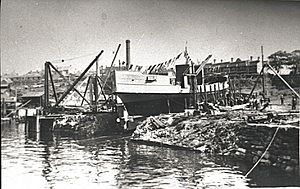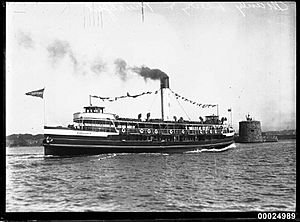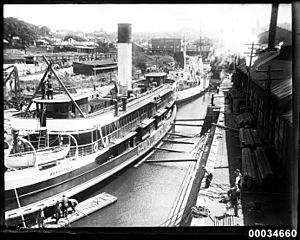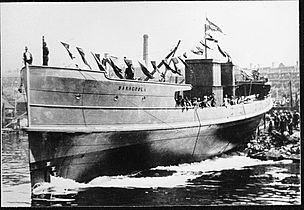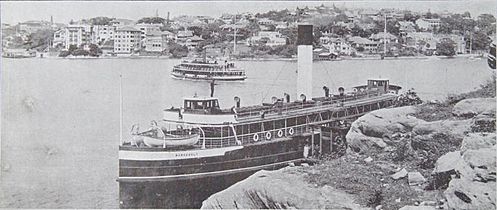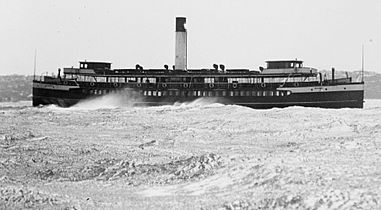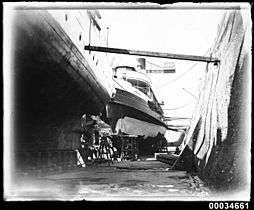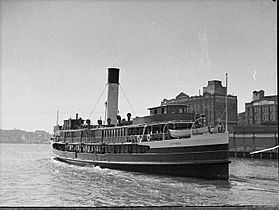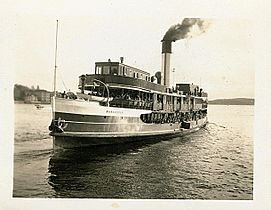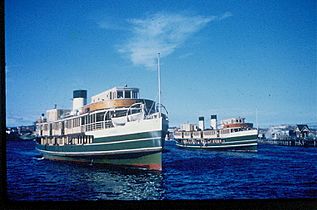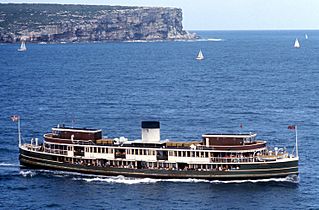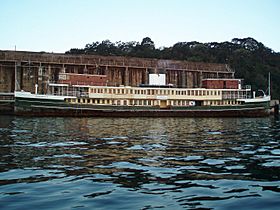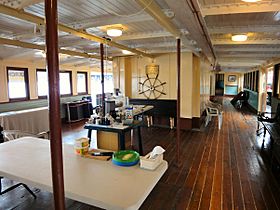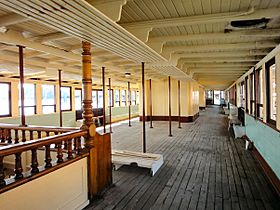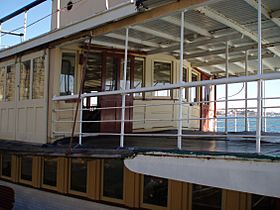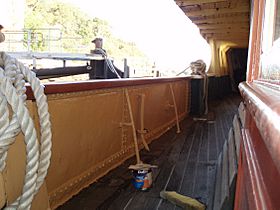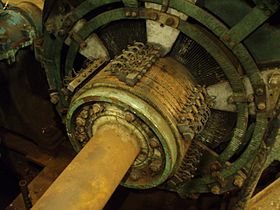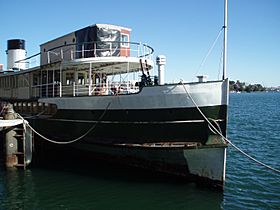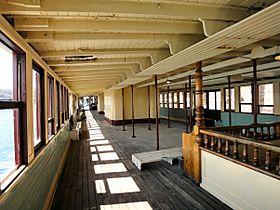MV Baragoola facts for kids
class="infobox " style="float: right; clear: right; width: 315px; border-spacing: 2px; text-align: left; font-size: 90%;"
| colspan="2" style="text-align: center; font-size: 90%; line-height: 1.5em;" | 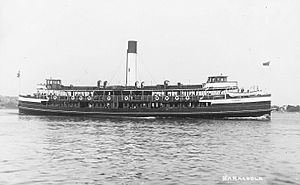
|}
The MV Baragoola (which means "flood tide" in an Aboriginal language) is a famous ferry. It used to carry people across Sydney Harbour on the Manly route. The ferry was built in 1922. It was the last of six similar ferries known as the Binngarra type.
Baragoola stopped being a regular ferry in 1983. Since then, different owners have tried to fix it up and give it a new purpose. It has been docked at Balls Head Bay in Sydney Harbour since 2003. People are still working to restore this historic vessel.
Contents
- How the Manly Ferries Began
- Building the Baragoola
- Baragoola in Service
- Life After Service
- Historic gallery
- Contemporary condition
- Images for kids
How the Manly Ferries Began
Kuring-gai(1901) was an early design for the "Binngarra-type" ferries. Notice its wheelhouses are in the middle, unlike Baragoolawhich had them at each end.
For a long time, the Port Jackson & Manly Steamship Company used mostly paddle steamers. These boats had large paddles on their sides to move through the water. It was hard to turn these big boats in the narrow parts of Sydney Harbour, especially at the busy Circular Quay.
To solve this, they needed "double-ended" boats. These boats could go forwards or backwards without turning around. But having a propeller at the front of a boat could slow it down. As technology improved, they made engines more powerful to overcome this problem.
The first ferries with propellers on the Manly route were the SS Manly (1896) and SS Kuring-gai (1901). These boats were designed to handle the rough seas near the Sydney Heads. The Kuring-gai was bigger and helped shape the design for the later "Binngarra-class" ferries.
The "Binngarra-class" ferries were designed by Mort's Dock. These included Binngarra (1905), Burra-Bra (1908), Bellubera (1910), Balgowlah (1912), Barrenjoey (1913), and Baragoola (1922). Baragoola was built at the Balmain yard, while the others were built at Woolwich. These ferries were some of the largest ships built in Australia at that time.
Building the Baragoola
Baragoola'slaunch day, 14 February 1922.
Baragoola cost between £75,000 and £85,000 to build. It was launched on February 14, 1922. Mrs Hunter McPherson officially launched the ship. It was the sixth and last of the "Binngarra" type ferries. Baragoola was about 6 meters shorter than its sister ships, but it was also wider.
The ferry weighs 498 tons and is 60.7 meters long. When it was first built, it used a steam engine. This engine had three cylinders and was very powerful. It also had two large boilers that made steam.
The brand new Baragooladoing sea trials in 1922 on Sydney Harbour.
During its tests in August 1922, Baragoola reached an average speed of 14.7 knots. A knot is a measure of speed for boats. It could go up to 15 knots at its fastest. Even though it met the speed requirements, it was slower than its sister ships. People sometimes called it the 'slow boat'.
The way Baragoola was set up inside was typical for Manly ferries. When it was first built, its upper deck was open. It could carry 1,218 passengers in summer and 926 in winter. After its upper decks were covered in the early 1930s, it could carry 1,523 passengers.
On the lower deck, there was a special area for ladies with toilets. There was also a main cabin and a smoking room, usually for men. This area also had the mail room. After World War 2, the ferry got new electro-hydraulic steering. This made it easier to steer than the old chain system.
In 1961, Baragoola was changed from a steamship to a diesel-electric ferry. Its tall funnel was replaced with a short, wide one. Four diesel engines were installed. These engines powered two new electric motors, allowing the ferry to reach 16 knots. These engines are quite rare today.
Baragoola in Service
Baragoola was involved in a few accidents during its time as a ferry. On Christmas Eve in 1926, it crashed into another ferry called Kosciusko. In September 1927, Baragoola ran over a lifeboat. Five people were thrown into the water, and one had to go to the hospital. Fishing boats rescued them.
Baragoolaat Mort's Dockaround 1930, after its upper decks were covered.
In August 1934, Baragoola hit and killed a whale. This event was widely reported in the news. It took nine days and many tries to remove the whale's body.
Like its sister ships, Baragoola's open upper deck was covered in 1931-1932. This made the ferry more comfortable for passengers. They also tried using powdered coal as fuel, but it made too much coal dust.
Between March and August 1939, Baragoola was changed to burn oil. This was like other ferries such as Curl Curl and South Steyne. Better propellers were also added. However, during the war, there was a shortage of oil. So, the ferry had to go back to burning coal. This meant it could only make a few trips a day.
In 1958, Baragoola was taken out of service for a major upgrade. Its steam engines were replaced with new diesel-electric engines. It returned to service in 1961. In 1973, it carried sightseers for the opening of the Sydney Opera House.
In 1972, the ferry company was sold to Brambles Limited. Baragoola was refitted in 1974. In December 1974, the NSW State Government took over the Manly ferry service. Baragoola's traditional green, cream, and brown colours were changed to blue and white.
After a new ferry, the Freshwater, arrived in 1982, Baragoola was taken out of service on January 8, 1983. This was a big news event. Another new ferry, Queenscliff, started service in 1983.
Life After Service
After its ferry service ended, Baragoola was sold to Bob Hyde. He planned to use it as a floating university, but this never happened. The ferry stayed docked at Rozelle Bay until 1988. Then, it was sold to David Ashton.
In late 2003, Baragoola was moved from Waterview Wharf to the Coal Loader in Balls Head Bay. It has been there ever since. In 2009, Adrian Thompson bought the ferry. He thought about scrapping it, which means taking it apart for materials.
However, in March 2010, Baragoola was sold to the Baragoola Preservation Association. This is a non-profit group that is working to restore the ferry. On December 1, 2010, an Australian Army training exercise with helicopters accidentally damaged parts of the ferry. Baragoola is now listed on the Australian Register of Historic Vessels.
Historic gallery
Being launched, 1922
| History | |
|---|---|
| Name |
|
| Owner | Baragoola Preservation Association Incorporated |
| Operator |
|
| Port of registry | Sydney |
| Route | Manly |
| Builder | Mort's Dock |
| Cost | £75,000 to £85,000 |
| Yard number | 41 |
| Launched | 14 February 1922 |
| Maiden voyage | 3 September 1922 |
| Out of service | 8 January 1983 |
| Identification | IMO number: 5036145 |
| Status | squat |
| General characteristics | |
| Tonnage | 498 tonnes |
| Length | 60.92 metres (199 feet) |
| Beam | 10.30 metres (33 feet) |
| Draught | 3.75 metres (12 feet) |
| Decks | 2 |
| Installed power | 4 × English Electric 7SKM diesels |
| Speed | 16 knots |
| Capacity | 1,523 |
| Crew | 11 (as SS), 7 (as MV) |
Crossing Sydney Heads in the early 1930s, after its wheelhouses were extended.
At Manly Wharf in 1951 as a steamship, showing the rebuilt wheelhouses. It was changed to diesel-electric in 1961.
Approaching Circular Quay after its 1961 change to diesel-electric power, with North Head behind it, 1964.
Crossing Sydney Heads with North Head in the background. As a Brambles Limited ferry, 1974.
Contemporary condition
Images for kids



